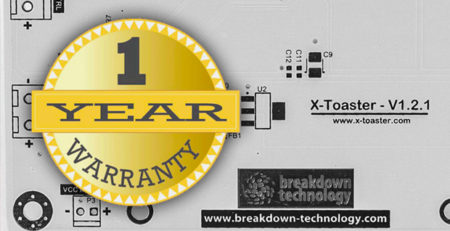Troubleshooting
Every X-toaster board is extensively tested so you shouldn’t have problems with your board.
For many smaller problems there are simple solutions:
The Board is not powering
Please check your power supply, it should be rated 5V@500mA. The board itself is usually drawing a maximum of 300mA so you should also be ok even with slightly smaller adapter.
If the power supply is ok you may have a damages fuse or rectifying diode. If that’s the case you can substitute them (D3, F1) with a low drop schottky diode in the DO214AA package and with a 375mA fast fuse in the 0805 package. After substituting them we suggest you to check what damaged those components and, eventually, to change your 5V power supply.
The Controller is not working properly, it keeps resetting
This may be a power supply issue as well. Make sure to use a good quality, stable power supply.
Another reason may be some kind of EMI interference or coupling. Try repositioning your oven, make sure to have all metal part connected to earth and consider using a shielded external housing for your board. A metal enclosure connected to ground should be enough. Depending on the SSR you are using this may also be a source of interference: try mounting the SSR in a different case or inside the oven itself. Also try repositioning your power supply.
Parameters and Profiles can’t be saved or contain garbage
A power supply problem while eeprom is written may result in corrupted eeprom and data.
Try restoring everything to default in the “System Settings” screen. If it doesn’t solve the problem you may have to erase completely the device eeprom. For that pourpose you can use an Atmel programmer and, within Atmel Studio, make a complete erase of ONLY the eeprom content. During next power up of the board, firmware will detect the empty eeprom and will rewrite all needed data.
The board is ok, but the heaters are not turning on
Firstly check again every single connection. Disconnect everything from main power and use a multimeter to check them. If your wiring is ok try connecting the heaters directly to main power bypassing the SSR: if they are powered the problem may be the SSR itself. Please note that some chineese producers often derate the minimum voltage needed to turn them on so, a 3V~32V SSR may probably need at least 5V to work properly. If you find that this is your case you can get another SSR (maybe from another producer) or you can bypass the rectifying diode D3, which provide a 250mV dropout from 5V power supply, with a short thick wire. In our test this is usually enough to be able to use every SSR on the market. As an alternative, if you know how to build one, you can assemble an external non inverting circuit with a BJT or a MOSFET to amplify the on/off signal from the board. In this way you can also use another higher voltage source (12V usually) dedicated to your SSR.
My reflowed boards are coming out burnt and damaged but the profile seems to be ok
Maybe you are leaving your thermocouple in free air. If you do not use a testing board of sizes and layout similar to the one you are reflowing, your thermocouple may read temperatures very different from the one you have on the reflowed board. There may be overshoots of 20/30°C thus leading to burnt boards.
Make sure to use a proper test board and to secure the tip of the thermocouple to a via or a plated hole possibly connected (and near) to the GND plane. Use a small quantity of thermal compound to ensure a good thermal transfer between the probe and the board and secure the thermocouple to the testing board with a couple of strips of kepton tape.
Also make sure that, when you open the oven’s door, temperature is dropping fast enough to remain into the JEDEC maximum time limit above liquidus. If not, you should use some fan or other ways to let your board cool faster.
Temperature read from the thermocouple oscillates and gives false results
If you have a fixed and stable error on your reading this is something that can simply be resolved by compensating for it in the “System Settings” screen.
If the errors comes out in an unpredictable way with very small or very large values this is definitely an EMI issue. MAX31855 is very sensitive to EMI and, though we made our best with the layout and the filtering components within the board, you will probably have to take more measures to improve shielding.
In our test we have seen that while most of the spectrum is affecting the chip readings, most of the interferences come from the microwave zone (cell phones).
Mount the controller into a grounded metal chassis, shorten thermocople wire as much as possible and avoid any coupling from the thermocouple itself and other source of interference (for example high voltage wires) by keeping them as far as possible.
If your problem is still present, please send us an email describing your specific issue, we will make our best to make your board live again or, if not possible, to repair it at the lower possible cost.
Also check the “Warranty” section.



